Development and Characterization of a Flexible Soundproofing Metapanel for Noise Reduction
Abstract
:Featured Application
Abstract
1. Introduction
2. Materials and Methods
2.1. Finiete Element (FE) Analysis
2.2. SPL Test for FSM
3. Results
3.1. Structure of Flexible Soundproofing Metapanel
3.1.1. Sound Transmission Loss of FSM
3.1.2. Design of Flexible Soundproofing Metapanel
- Unit cell dimensions: Lx = Ly = 5.5 mm, Lz = 3.5 mm;
- Frame thickness: tf = 0.5 mm;
- Material: Urethane rubber with a Young’s modulus of 6.5 MPa;
- Membrane thickness: tm = 0.6 mm.
3.2. SPL Test for Enclosure-Type FSM
4. Conclusions
Author Contributions
Funding
Institutional Review Board Statement
Informed Consent Statement
Data Availability Statement
Conflicts of Interest
References
- Brekhovskikh, L. Waves in Layered Media; Elsevier: Amsterdam, The Netherlands, 2012; ISBN 978-0-323-16162-6. [Google Scholar]
- Yang, M.; Sheng, P. Sound Absorption Structures: From Porous Media to Acoustic Metamaterials. Annu. Rev. Mater. Res. 2017, 47, 83–114. [Google Scholar] [CrossRef]
- Bonnecaze, R.T.; Rodin, G.J.; Sigmund, O.; Søndergaard Jensen, J. Systematic Design of Phononic Band–Gap Materials and Structures by Topology Optimization. Philos. Trans. R. Soc. London. Ser. A Math. Phys. Eng. Sci. 2003, 361, 1001–1019. [Google Scholar] [CrossRef]
- Al Ba’ba’a, H.; Nouh, M.; Singh, T. Formation of Local Resonance Band Gaps in Finite Acoustic Metamaterials: A Closed-Form Transfer Function Model. J. Sound Vib. 2017, 410, 429–446. [Google Scholar] [CrossRef]
- D’Alessandro, L.; Belloni, E.; Ardito, R.; Braghin, F.; Corigliano, A. Mechanical Low-Frequency Filter via Modes Separation in 3D Periodic Structures. Appl. Phys. Lett. 2017, 111, 231902. [Google Scholar] [CrossRef]
- Wang, Q.; Li, J.; Zhang, Y.; Xue, Y.; Li, F. Bandgap Properties in Metamaterial Sandwich Plate with Periodically Embedded Plate-Type Resonators. Mech. Syst. Signal Process. 2021, 151, 107375. [Google Scholar] [CrossRef]
- Comi, C.; Driemeier, L. Wave Propagation in Cellular Locally Resonant Metamaterials. Lat. Am. J. Solids Struct. 2018, 15, e38. [Google Scholar] [CrossRef]
- Gao, N.; Zhang, Z.; Deng, J.; Guo, X.; Cheng, B.; Hou, H. Acoustic Metamaterials for Noise Reduction: A Review. Adv. Mater. Technol. 2022, 7, 2100698. [Google Scholar] [CrossRef]
- Liu, C.; Chen, L.; Lee, H.P.; Yang, Y.; Zhang, X. A Review of the Inerter and Inerter-Based Vibration Isolation: Theory, Devices, and Applications. J. Frankl. Inst. 2022, 359, 7677–7707. [Google Scholar] [CrossRef]
- Sheng, P.; Fang, X.; Dai, L.; Yu, D.; Wen, J. Synthetical Vibration Reduction of the Nonlinear Acoustic Metamaterial Honeycomb Sandwich Plate. Mech. Syst. Signal Process. 2023, 185, 109774. [Google Scholar] [CrossRef]
- Sugino, C.; Xia, Y.; Leadenham, S.; Ruzzene, M.; Erturk, A. A General Theory for Bandgap Estimation in Locally Resonant Metastructures. J. Sound Vib. 2017, 406, 104–123. [Google Scholar] [CrossRef]
- Lee, S.H.; Park, C.M.; Seo, Y.M.; Wang, Z.G.; Kim, C.K. Acoustic Metamaterial with Negative Density. Phys. Lett. A 2009, 373, 4464–4469. [Google Scholar] [CrossRef]
- Lee, S.H.; Wright, O.B. Origin of Negative Density and Modulus in Acoustic Metamaterials. Phys. Rev. B 2016, 93, 024302. [Google Scholar] [CrossRef]
- Yao, S.; Zhou, X.; Hu, G. Investigation of the Negative-Mass Behaviors Occurring below a Cut-off Frequency. New J. Phys. 2010, 12, 103025. [Google Scholar] [CrossRef]
- Wang, S.; Xiao, Y.; Guo, J.; Zhang, H.; Wen, J. Broadband Diffuse Field Sound Insulation of Double Layer Metamaterial Plates Lined with Porous Material. Appl. Phys. Lett. 2021, 119, 084103. [Google Scholar] [CrossRef]
- Ghaffarivardavagh, R.; Nikolajczyk, J.; Anderson, S.; Zhang, X. Ultra-Open Acoustic Metamaterial Silencer Based on Fano-like Interference. Phys. Rev. B 2019, 99, 024302. [Google Scholar] [CrossRef]
- Yu, X.; Lu, Z.; Liu, T.; Cheng, L.; Zhu, J.; Cui, F. Sound Transmission through a Periodic Acoustic Metamaterial Grating. J. Sound Vib. 2019, 449, 140–156. [Google Scholar] [CrossRef]
- Sun, M.; Fang, X.; Mao, D.; Wang, X.; Li, Y. Broadband Acoustic Ventilation Barriers. Phys. Rev. Appl. 2020, 13, 044028. Available online: https://journals.aps.org/prapplied/abstract/10.1103/PhysRevApplied.13.044028 (accessed on 26 August 2024). [CrossRef]
- Park, J.; Kwak, J.-H.; Song, K. Ultraslow Medium with an Acoustic Membrane-like Undamped Dynamic Vibration Absorber for Low-Frequency Isolation. Extrem. Mech. Lett. 2021, 43, 101203. [Google Scholar] [CrossRef]
- Jang, J.-Y.; Park, C.-S.; Song, K. Lightweight Soundproofing Membrane Acoustic Metamaterial for Broadband Sound Insulation. Mech. Syst. Signal Process. 2022, 178, 109270. [Google Scholar] [CrossRef]
- Li, Y.; Zhang, Y.; Xie, S. A Lightweight Multilayer Honeycomb Membrane-Type Acoustic Metamaterial. Appl. Acoust. 2020, 168, 107427. [Google Scholar] [CrossRef]
- Hu, G.; Tang, L.; Cui, X. On the Modelling of Membrane-Coupled Helmholtz Resonator and Its Application in Acoustic Metamaterial System. Mech. Syst. Signal Process. 2019, 132, 595–608. [Google Scholar] [CrossRef]
- Yang, Z.; Mei, J.; Yang, M.; Chan, N.H.; Sheng, P. Membrane-Type Acoustic Metamaterial with Negative Dynamic Mass. Phys. Rev. Lett. 2008, 101, 204301. [Google Scholar] [CrossRef] [PubMed]
- Yang, Z.; Dai, H.M.; Chan, N.H.; Ma, G.C.; Sheng, P. Acoustic Metamaterial Panels for Sound Attenuation in the 50–1000 Hz Regime. Appl. Phys. Lett. 2010, 96, 041906. [Google Scholar] [CrossRef]
- Mei, J.; Ma, G.; Yang, M.; Yang, Z.; Wen, W.; Sheng, P. Dark Acoustic Metamaterials as Super Absorbers for Low-Frequency Sound. Nat. Commun. 2012, 3, 756. [Google Scholar] [CrossRef] [PubMed]
- Kim, J.; Choi, E.; Jeon, W. Lightweight Soundproofing Meta-Panel for Separate Wide Frequency Bands. Mech. Syst. Signal Process. 2023, 184, 109647. [Google Scholar] [CrossRef]
- Malléjac, M.; Merkel, A.; Sánchez-Dehesa, J.; Christensen, J.; Tournat, V.; Groby, J.-P.; Romero-García, V. Zero-Phase Propagation in Realistic Plate-Type Acoustic Metamaterials. Appl. Phys. Lett. 2019, 115, 134101. [Google Scholar] [CrossRef]
- Beheshti, M.H.; Emkani, M.; Borhani Jebeli, M.; Tajpoor, A.; Firoozi Chahack, A.; Yarahmadi, G.; Piramoon, H.; Khoshehsahi, S.; Zobeidi, N. The Effect of Sound with Different Frequencies on Men and Women Noise Annoyance. J. Res. Health 2019, 9, 355–362. [Google Scholar] [CrossRef]
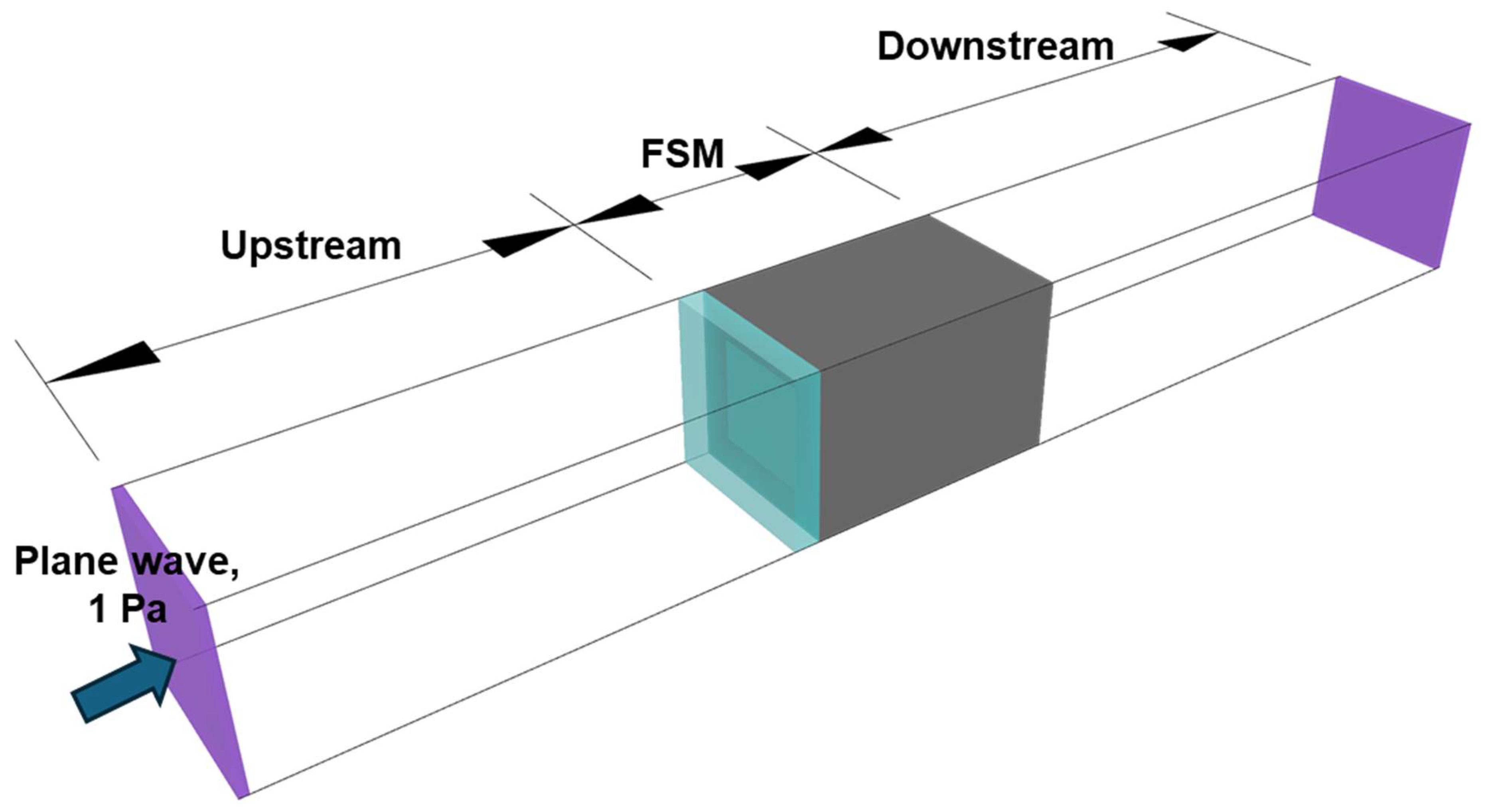
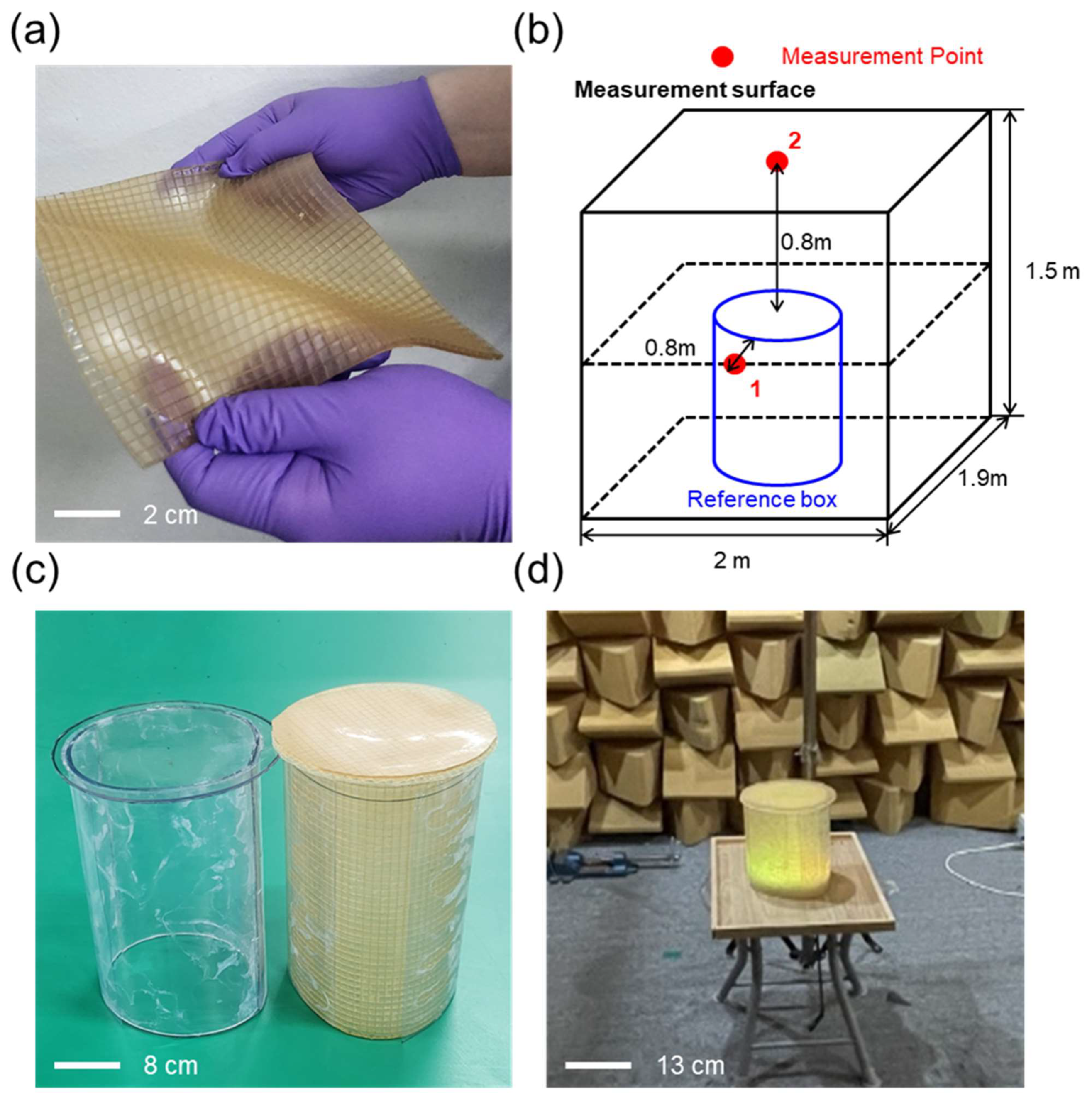

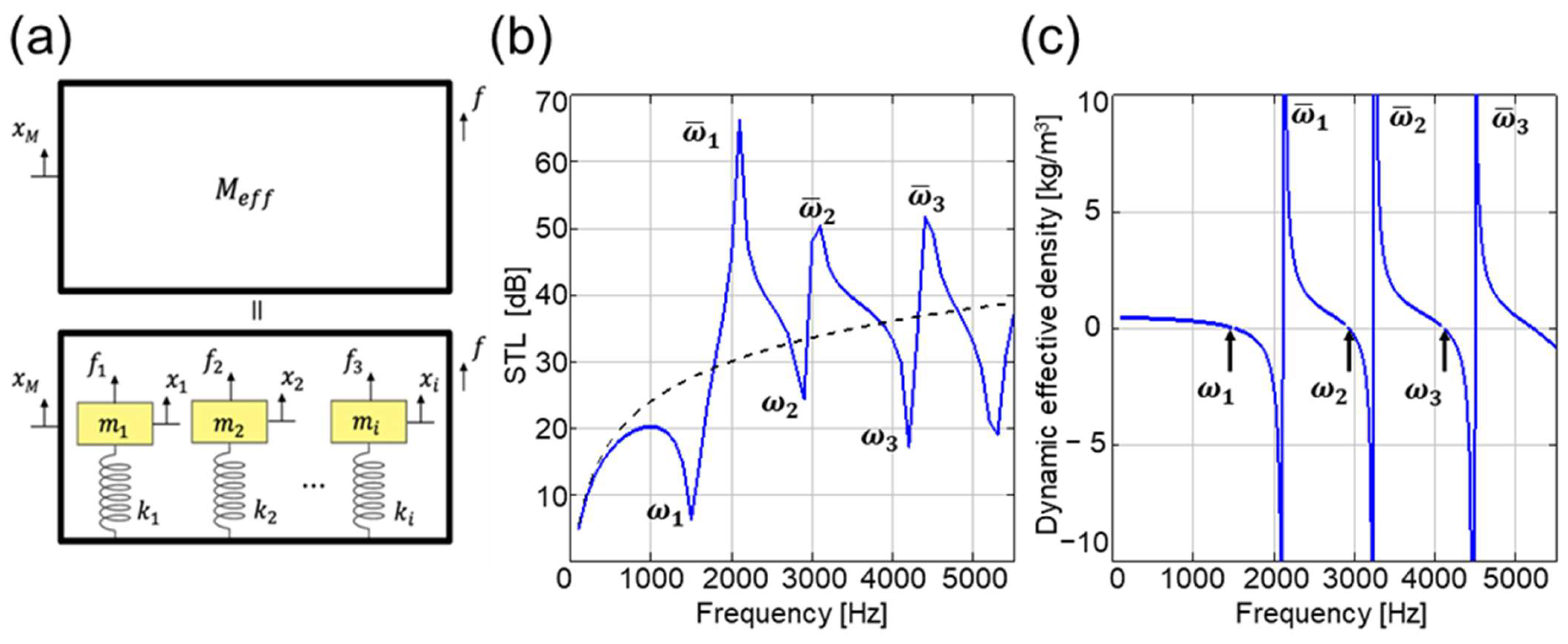
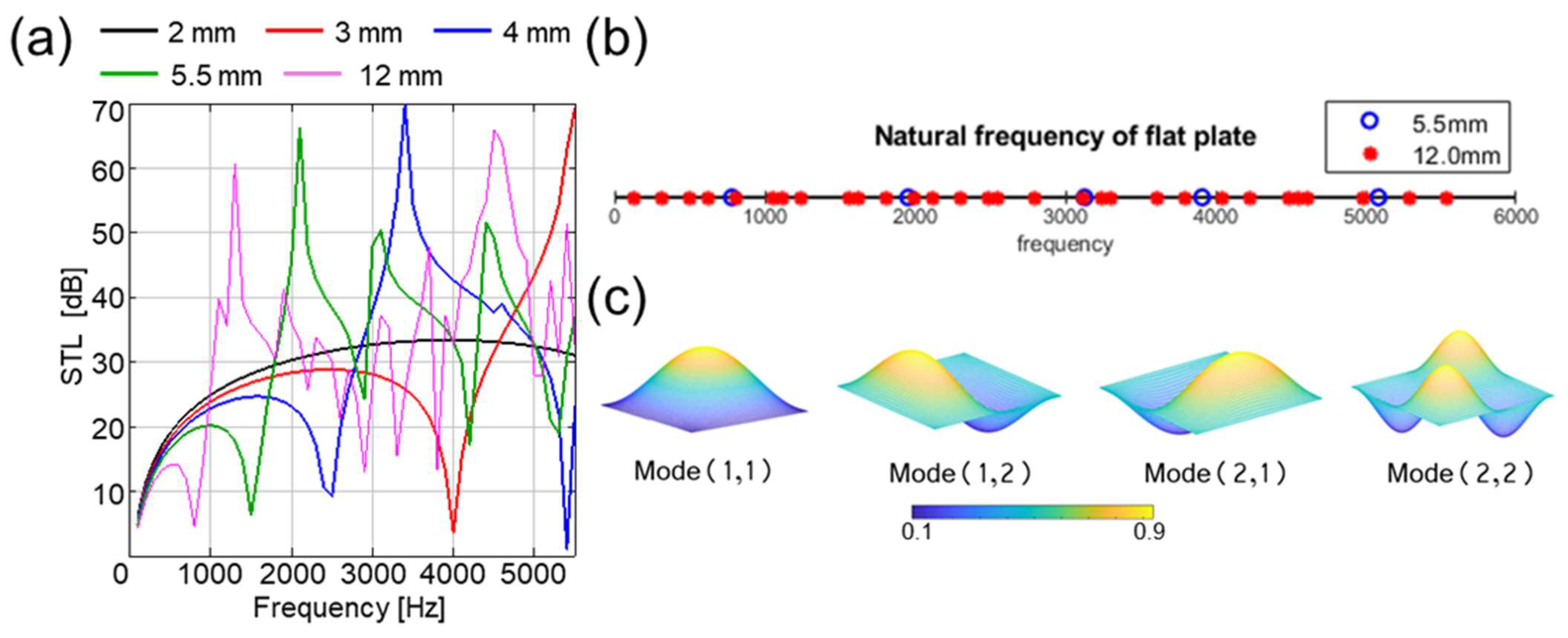
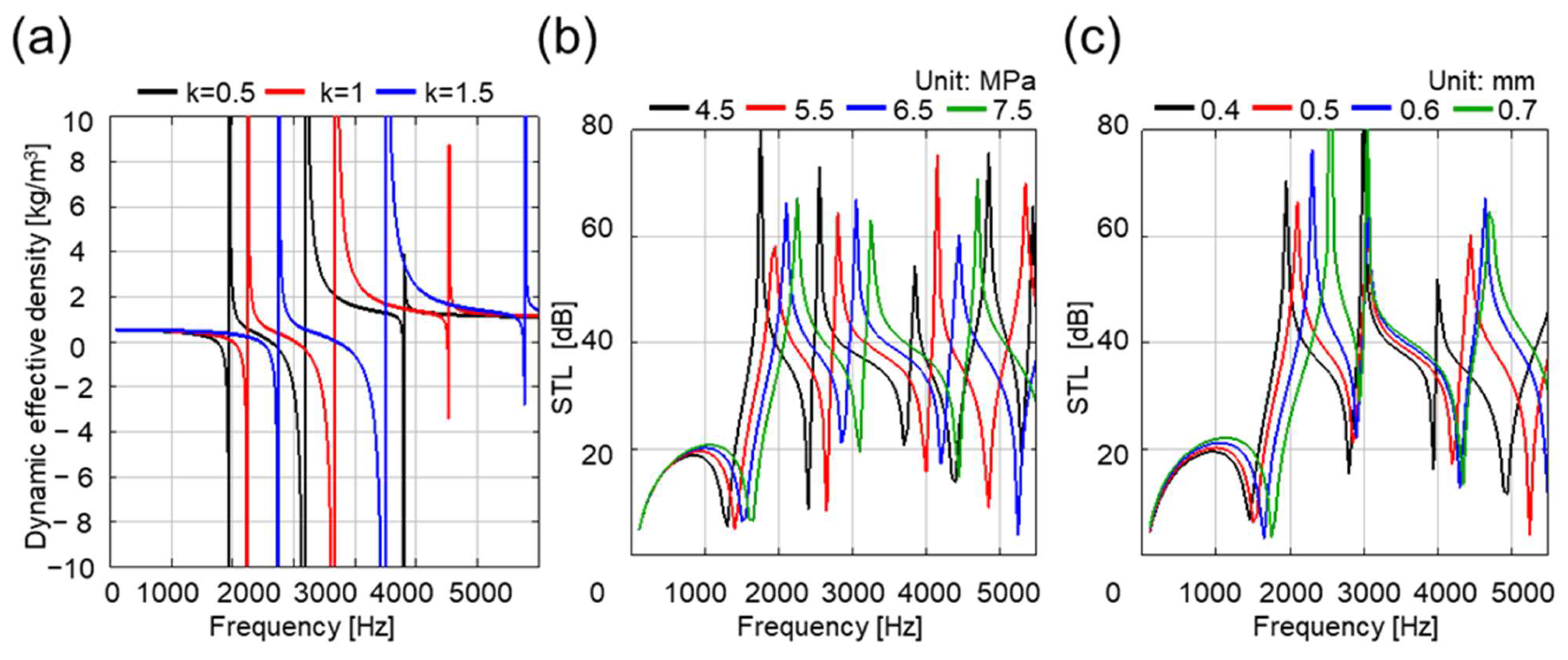
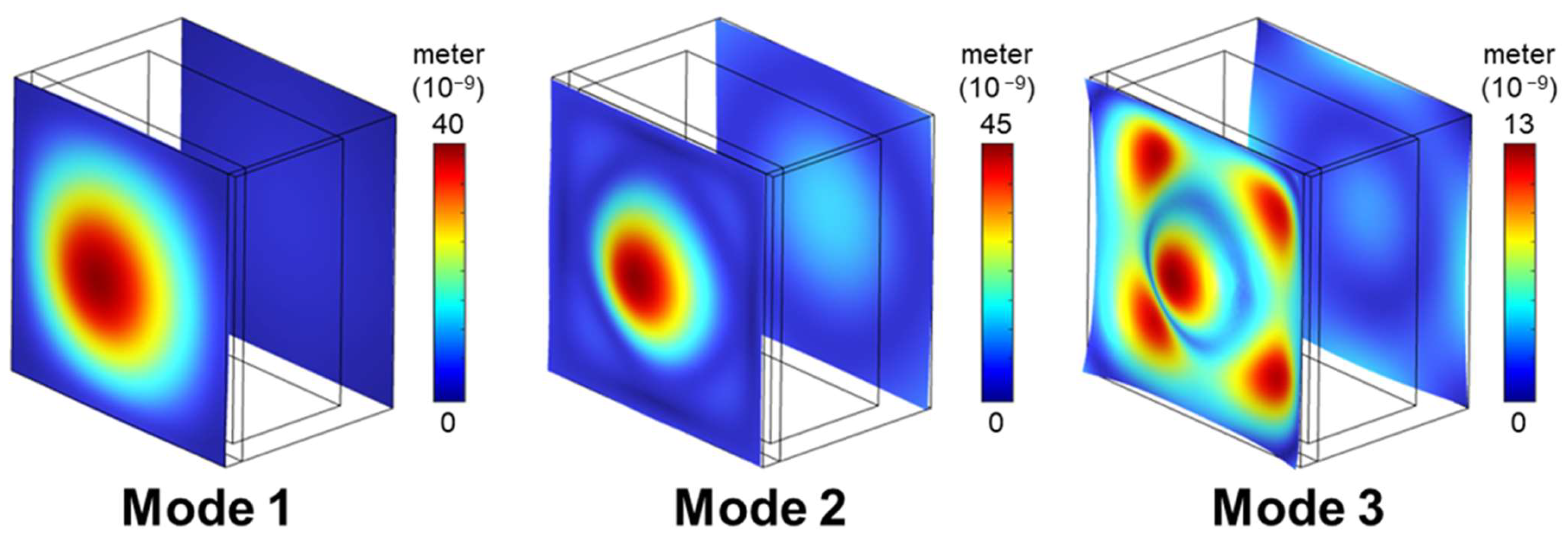
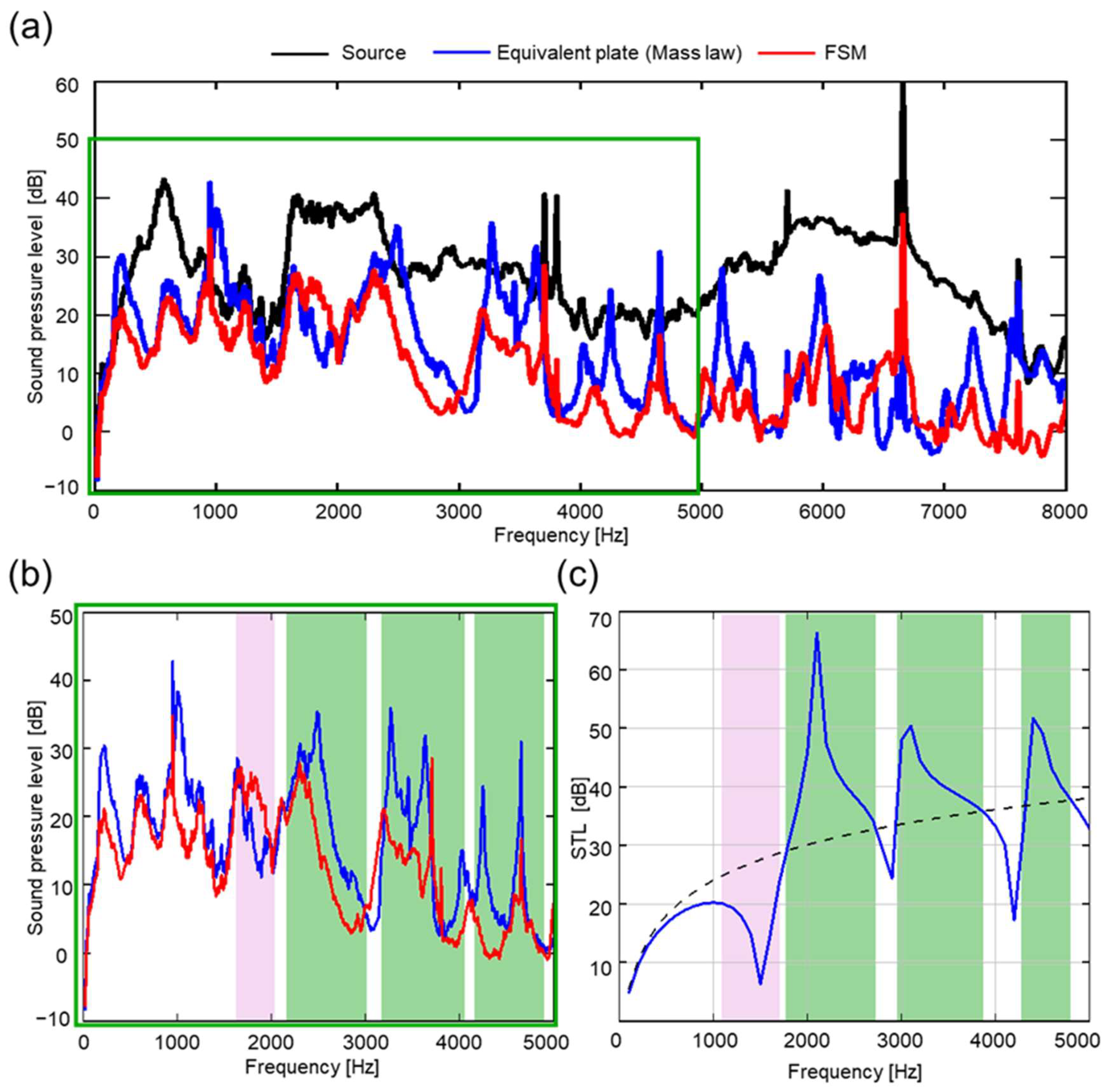
Disclaimer/Publisher’s Note: The statements, opinions and data contained in all publications are solely those of the individual author(s) and contributor(s) and not of MDPI and/or the editor(s). MDPI and/or the editor(s) disclaim responsibility for any injury to people or property resulting from any ideas, methods, instructions or products referred to in the content. |
© 2024 by the authors. Licensee MDPI, Basel, Switzerland. This article is an open access article distributed under the terms and conditions of the Creative Commons Attribution (CC BY) license (https://creativecommons.org/licenses/by/4.0/).
Share and Cite
Jang, D.; Kang, S.; Kim, J.; Kim, H.; Lee, S.; Kim, B. Development and Characterization of a Flexible Soundproofing Metapanel for Noise Reduction. Appl. Sci. 2024, 14, 8833. https://doi.org/10.3390/app14198833
Jang D, Kang S, Kim J, Kim H, Lee S, Kim B. Development and Characterization of a Flexible Soundproofing Metapanel for Noise Reduction. Applied Sciences. 2024; 14(19):8833. https://doi.org/10.3390/app14198833
Chicago/Turabian StyleJang, Dongil, Sanha Kang, Jinyoung Kim, Hyeonghoon Kim, Sinwoo Lee, and Bongjoong Kim. 2024. "Development and Characterization of a Flexible Soundproofing Metapanel for Noise Reduction" Applied Sciences 14, no. 19: 8833. https://doi.org/10.3390/app14198833





